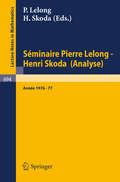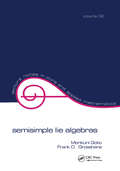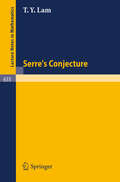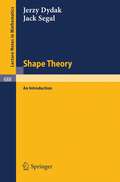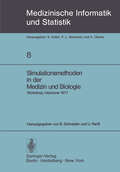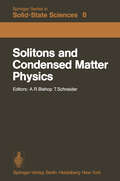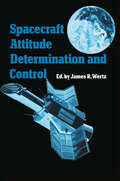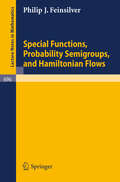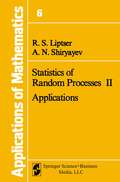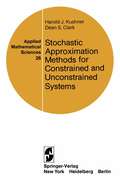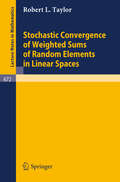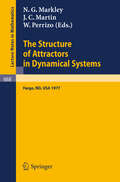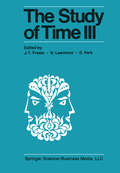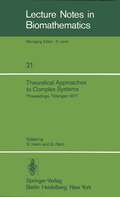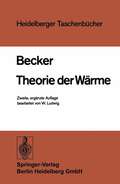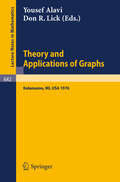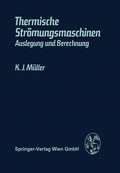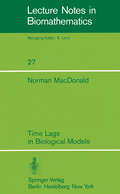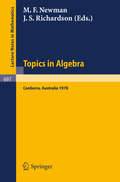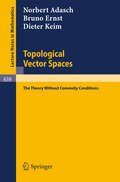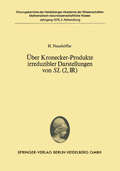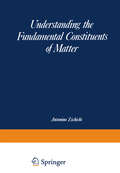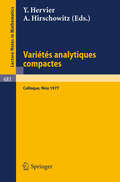- Table View
- List View
Séminaire Pierre Lelong - Henri Skoda: Année 1976-77 (Lecture Notes in Mathematics #694)
by P. Lelong H. SkodaSemisimple Lie Algebras
by Morikuni Goto Frank D. GrosshansThis book provides an account of part of the theory of Lie algebras most relevant to Lie groups. It discusses the basic theory of Lie algebras, including the classification of complex semisimple Lie algebras, and the Levi, Cartan and Iwasawa decompositions.
Semisimple Lie Algebras
by Morikuni Goto Frank D. GrosshansThis book provides an account of part of the theory of Lie algebras most relevant to Lie groups. It discusses the basic theory of Lie algebras, including the classification of complex semisimple Lie algebras, and the Levi, Cartan and Iwasawa decompositions.
Serre's Conjecture (Lecture Notes in Mathematics #635)
by T.Y. LamFrom the Preface: "I felt it would be useful for graduate students to see a detailed account of the sequence of mathematical developments which was inspired by the Conjecture, and which ultimately led to its full solution.... I offered a course on Serre's Conjecture to a small group of graduate students in January, 1977 [at the University of California, Berkeley] one year after its solution by Quillen and Suslin. My course was taught very much in the spirit of a mathematical 'guided tour'. Volunteering as the guide, I took upon myself the task of charting a route through all the beautiful mathematics surrounding the main problem to be treated; the 'guide' then leads his audience through the route, on to the destination, pointing out the beautiful sceneries and historical landmarks along the way."
Simulationsmethoden in der Medizin und Biologie: Workshop, Hannover, 29. Sept.–1. Okt. 1977 (Medizinische Informatik, Biometrie und Epidemiologie #8)
by B. Schneider U. RanftSolitons and Condensed Matter Physics: Proceedings of the Symposium on Nonlinear (Soliton) Structure and Dynamics in Condensed Matter, Oxford, England, June 27–29, 1978 (Springer Series in Solid-State Sciences #8)
by A. R. Bishop T. SchneiderSpacecraft Attitude Determination and Control (Astrophysics and Space Science Library #73)
by J. R. WertzRoger D. Werking Head, Attitude Determination and Control Section National Aeronautics and Space Administration/ Goddard Space Flight Center Extensiye work has been done for many years in the areas of attitude determination, attitude prediction, and attitude control. During this time, it has been difficult to obtain reference material that provided a comprehensive overview of attitude support activities. This lack of reference material has made it difficult for those not intimately involved in attitude functions to become acquainted with the ideas and activities which are essential to understanding the various aspects of spacecraft attitude support. As a result, I felt the need for a document which could be used by a variety of persons to obtain an understanding of the work which has been done in support of spacecraft attitude objectives. It is believed that this book, prepared by the Computer Sciences Corporation under the able direction of Dr. James Wertz, provides this type of reference. This book can serve as a reference for individuals involved in mission planning, attitude determination, and attitude dynamics; an introductory textbook for stu dents and professionals starting in this field; an information source for experimen ters or others involved in spacecraft-related work who need information on spacecraft orientation and how it is determined, but who have neither the time nor the resources to pursue the varied literature on this subject; and a tool for encouraging those who could expand this discipline to do so, because much remains to be done to satisfy future needs.
Special Functions, Probability Semigroups, and Hamiltonian Flows (Lecture Notes in Mathematics #696)
by P. J. FeinsilverStatistics of Random Processes II: Applications (Stochastic Modelling and Applied Probability #6)
by R.S. Liptser A.N. ShiryayevStochastic Approximation Methods for Constrained and Unconstrained Systems (Applied Mathematical Sciences #26)
by H.J. Kushner D.S. ClarkThe book deals with a powerful and convenient approach to a great variety of types of problems of the recursive monte-carlo or stochastic approximation type. Such recu- sive algorithms occur frequently in stochastic and adaptive control and optimization theory and in statistical esti- tion theory. Typically, a sequence {X } of estimates of a n parameter is obtained by means of some recursive statistical th st procedure. The n estimate is some function of the n_l estimate and of some new observational data, and the aim is to study the convergence, rate of convergence, and the pa- metric dependence and other qualitative properties of the - gorithms. In this sense, the theory is a statistical version of recursive numerical analysis. The approach taken involves the use of relatively simple compactness methods. Most standard results for Kiefer-Wolfowitz and Robbins-Monro like methods are extended considerably. Constrained and unconstrained problems are treated, as is the rate of convergence problem. While the basic method is rather simple, it can be elaborated to allow a broad and deep coverage of stochastic approximation like problems. The approach, relating algorithm behavior to qualitative properties of deterministic or stochastic differ ential equations, has advantages in algorithm conceptualiza tion and design. It is often possible to obtain an intuitive understanding of algorithm behavior or qualitative dependence upon parameters, etc., without getting involved in a great deal of deta~l.
Stochastic Convergence of Weighted Sums of Random Elements in Linear Spaces (Lecture Notes in Mathematics #672)
by Robert L. TaylorThe Structure of Attractors in Dynamical Systems: Proceedings, North Dakota State University, June 20-24, 1977 (Lecture Notes in Mathematics #668)
by N. G. Markley J. C. Martin W. PerrizoThe Study of Time III: Proceedings of the Third Conference of the International Society for the Study of Time Alpbach—Austria
by J. T. Fraser N. Lawrence D. ParkThe papers in this volume were delivered and responded to at the Third Conference of the International Society for the Study of Time. The meeting took place during sunny days, punctuated by an occasional brief storm, in the confer ence facilities of the Österreichisches College in Alpbach, Austria, from ]uly 1 to ]uly 10, 1976. In the middle of it came ]uly 4, the 200th anniversary of the Declaration ofindependence, and in honor ofparticipants from the United States there was a special session of papers on the subject of Freedom and Time. [See Fraser, Park in this volume. ] The effect of the papers was kaleidoscopic; reading the table of contents one can surmise the experience of those enthusiasts, and there were several, who heard them all. I think that most people who have been puzzled about time will agree that it is not clear wh at the puzzle is or from what direction the insights will come that will enable us to understand the situation a litde more clearly. As one of the participants wrote afterwards, "After all , we do not know apriori whether there exists areal unity in studies about time, but if one exists it must reveal itself progressively in the course of successive experiences such as these lectures. If it were easy to find, it would have been found already without the Society's help.
Theoretical Approaches to Complex Systems: Proceedings, Tübingen, June 11–12, 1977 (Lecture Notes in Biomathematics #21)
by R. Heim G. PalmTheorie der Wärme (Heidelberger Taschenbücher #10)
by R. Becker63 heit aufgefaßt werden muß. Dabei werden sich als Resultate von zentraler Be deutung ergeben: Diejenige Größe, welche die ganze Thermodynamik beherrscht, nämlich die Entropie, erweist sich als quantitatives Maß der soeben geschilderten Unkenntnis. Das ist fraglos eine der merkwürdigsten und tiefstliegenden Aus sagen der ganzen Physik. Sie wird natürlich nur sinnvoll durch eine exakte Formulierung, welche erst nach den Vorarbeiten der nächsten Abschnitte erfolgen kann. Ein beherrschender Zug der statistischen Mechanik besteht darin, daß die Zahl der mikroskopischen Freiheitsgrade - im wesentlichen gegeben durch die Zahl N der im System enthaltenen Atome - so ungeheuer groß ist. Obwohl mit wachsendem N unsere Kenntnis von der mikroskopischen Struktur immer geringer wird, werden dennoch die oben angedeuteten Wahrscheinlichkeitsaus sagen über makroskopische Größen um so schärfer, je größer N ist, in dem Sinne, daß wir im Limes N --* 00 wieder zu sicheren Aussagen gelangen. Dieser Zug der Wahrscheinlichkeitsrechnung ist so charakteristisch, daß wir ihn gleich jetzt an einem primitiven Beispiel erläutern wollen. Ein Gas bestehe aus N Molekülen, welche sich unabhängig voneinander in einem Volumen V bewegen (ideales Gas). Wir grenzen innerhalb V ein dagegen kleines Volumen v ab und interessieren uns für die Zahl n der Molekiile, welche sich in v aufhalten. Nennen wir und 1- P = q, ~=p so sind p bzw. q die Wahrscheinlichkeiten dafür, ein hervorgehobenes Molekül innerhalb bzw. außerhalb v zu finden.
Theory and Applications of Graphs: Proceedings, Michigan, May 11 - 15, 1976 (Lecture Notes in Mathematics #642)
by Y. Alavi D. R. LickTime Lags in Biological Models (Lecture Notes in Biomathematics #27)
by N. MacDonaldIn many biological models it is necessary to allow the rates of change of the variables to depend on the past history, rather than only the current values, of the variables. The models may require discrete lags, with the use of delay-differential equations, or distributed lags, with the use of integro-differential equations. In these lecture notes I discuss the reasons for including lags, especially distributed lags, in biological models. These reasons may be inherent in the system studied, or may be the result of simplifying assumptions made in the model used. I examine some of the techniques available for studying the solution of the equations. A large proportion of the material presented relates to a special method that can be applied to a particular class of distributed lags. This method uses an extended set of ordinary differential equations. I examine the local stability of equilibrium points, and the existence and frequency of periodic solutions. I discuss the qualitative effects of lags, and how these differ according to the choice of discrete or distributed lag. The models studied are drawn from the population dynamiCS of single species (logistic growth, the chemostat) and of interacting pairs of species (predation, mutualism), from cell population dynamiCS (haemopoiesis) and from biochemical kinetics (the Goodwin oscillator). The last chapter is devoted to a population model employing difference equations. All these models include non-linear terms.
Topics in Algebra: Proceedings, 18th Summer Research Institute of the Australian Mathematical Society, Australian National University, Canberra, January 9 - February 17, 1978 (Lecture Notes in Mathematics #697)
by M. F. Newman J. S. RichardsonTopological Vector Spaces: The Theory Without Convexity Conditions (Lecture Notes in Mathematics #639)
by Norbert Adasch Bruno Ernst Dieter KeimÜber Kronecker-Produkte irreduzibler Darstellungen von SL: Vorgelegt in der Sitzung vom 22. April 1978 (Sitzungsberichte der Heidelberger Akademie der Wissenschaften #1978 / 3)
by H. NeunhöfferUnderstanding the Fundamental Constituents of Matter (The Subnuclear Series #14)
by Antonio ZichichiDuring July and August of 1976 a group of 90 physicists from 56 laboratories in 21 countries met in Erice for the 14th Course of the International School of Subnuclear Physics. The countries represented were Argentina, Australia, Austria, Belgium, Denmark, the Federal Republic of Germany, France, the German Democratic Republic, Greece, Israel, Italy, Japan, Mexico, Nigeria, Norway, Sweden, the United Kingdom, the United States of America, Vietnam, and Yugoslavia. The School was sponsored by the Italian Ministry of Public Education (MPI), the Italian Ministry of Scientific and Technological Research (MRST), the North Atlantic Treaty Organi zation (NATO), the Regional Sicilian Government (ERS), and the Weizmann Institute of Science. The program of the School was mainly devoted to the elucida tion and discussion of the progress achieved in the theoretical and experimental understanding of the fundamental constituents of matter. On the theoretical front we had a series of remarkable lecturers (C. N. Yang, S. Weinberg, G. C. Wick) attempting a description of finite size particles. Another group of lecturers covered such topics as the understanding of the new particles (H. J. Lipkin), whether or not jets really exist (E. Lillethun), and the unexpected A-dependence of massive dileptons produced in high-energy proton- nucleus collisions (J. W. Cronin). Two other outstanding questions were covered by E. Leader and G. Preparata respectively: whether strong interactions are still within the Regge framework, and if it is really possible to master strong interactions. A. J. S.
